A table, a drink, an artist of silence
- rosemary
- Nov 17, 2021
- 6 min read
"a dreamy ambience of silence and stillness." Christies

I am not an artist, or even very well versed in art criticism, but I do enjoy art, and, as you know I have one of those desk calendars of art. Today my picture was by an artist unknown to me - Henri Le Sidaner. It wasn't this one, it was a rather lovely, and still painting of a street leading to a church. But when I looked into the artist and his work, I found that in the early 1900s he painted a large number of paintings of beautiful empty tables in beautiful settings. So I thought I would show you some of them and muse a tiny bit on them.

The picture above was the one that first struck my eye. It reminded me of the cover of one of the editions of Elizabeth David's A Book of Mediterranean Food. However, I now see that really the only thing the two have in common is that there is a table and a view of the sea. Elizabeth David's table is laden with food and the sun shines. There is no window, just a terrace or balcony. It's sort of messy and joie de vivre, whilst Le Sidaner's is 'prettier', more elegant. The light is fading, and there is no-one there, but it's inviting. Or have the occupants left the table for other delights? It's the sort of painting that poses questions. A table around which a story could be written. A moment in time. The people may not actually be there, but you feel that they are not far away. Although, now I see there is only one cup. Maybe he/she has gone out for a walk, to get a book to read ...
None of his tables are populated by people - unlike all those paintings of afternoon tea that I featured recently. Indeed some of them don't even have chairs.
"These familiar objects supplied in the absence of people make one think that people have just left, and are nearby, or will return to lend the objects an animation that was only temporarily absent" Catherine Lévy-Lambert
For yes, the tables are always carefully laid, there is always something to drink - wine, water, tea - the glasses have been poured, there is sometimes fruit, or patisseries to eat, but more often than not the emphasis is on drink not food. And the view. Always the view.
For beyond the tables are landscapes:
"a fleeting moment in time through the use of lights and shadows, and his depiction of the exterior world as seen from the domestic interior." Christies
Often the landscape includes water, but in his later years they focussed on his home in Gerberoy in Picardy. The table is set in a courtyard and its garden on which he apparently spent a lot of time and energy. Now he has been criticised in some quarters for having such a narrow focus, which seems a bit picky to me - consider Monet's haystacks and water lilies. Nobody criticises them for narrow focus.
He has also been criticised for painting:
"post office calendar landscapes painted in petit point" John Rewald
And so I cringe because I like them so much. Again, in my defence I will turn to Monet - aren't his paintings a bit chocolate box and post office calendar too? Monet's paintings are worth millions. I checked on Henry Le Sidaner, and found two that sold for around half a million US dollars. Much less than Monet, but not cheap either. So somebody must think they are good. I think it's the feelings that they inspire, sometimes melancholy, sometimes, calm, peace, and mystery too. And yes, although carefully arranged and posed, they are also moments in time. The table is laid - come and enjoy a drink before dinner.
What is it about tables that artists like? Still lives are almost invariably on a table - which often is a significant part of the painting. But a still life is that. Still, almost lifeless. An arrangement of objects, that together mean something. But not necessarily associated with people. Then there are those afternoon tea kind of paintings which show people interacting, in all manner of ways. These tables have no people, and yet they are imbued with life. Something has happened or is about to. The laid table has a purpose other than to be painted.
They are not everyday tables though are they? They are too beautiful for that. So shouldn't we make our everyday tables beautiful, set them in a beautiful setting, collect flowers, or even leaves. Throw a beautiful tablecloth over the table. Beauty is important. It lifts the spirit. And in that most domestic setting - a table set for a snack or a meal, or a drink - we can create beauty.
As well as tables he is also famous for painting scenes at twilight and so the choice of that particular painting as my 'header' is particularly apt. Twilight is a magic hour. Neither day, nor night, soft and expectant, the quiet at the end of a busy day. The universe is on display in the sky and reflected on the water and the glass. Henri Le Sidaner must have loved this time. Not many other artists, I can think of, focus on it to such an extent.
I haven't actually kept the titles of these paintings but in a way I don't think they matter, as they are mostly just vague titles that don't tell you much. Indeed I can't find a title for my header painting - well I think it's simply - Table.
So here are a few more for you to enjoy, or scorn, or muse upon. Always a background view, almost always subdued colours, although the night-time scene has spots of bright colour from the lamp. And the final table has no drinks, no chairs, no tablecloth - just three roses - it's name - carelessly resting on the table. Why?
His contemporaries sometimes criticised him for his pastel colour palette. And indeed most of his paintings are not bright, although in later life there seems to be more colour.

"It wasn’t that he didn’t do colour — the red of ‘La Nappe rouge, Versailles’ (1931) is as saturated as you could find in any painting by Bonnard or even Matisse — but that his colours are always diffused in an opal light that falls through the picture space like soft rain. He was as interested as Seurat in perception, but the science of optics left him cold. The point of his dots was to make his picture surfaces tremble like images hovering on the edge of perception." Laura Gascoigne - The Spectator
And my header picture is colourful too with its bright pink tablecloth and blue sea.
But he did do white and grey brilliantly, with one critic likening the white to Whistler and his beautiful women floating around in white:
Serene, tantalising. Easy to live with and have hanging on your wall to speculate upon endlessly.
"a contemporary of the Post-Impressionists who painted in dots but was not a Pointillist; revelled in complementary colours but was not a Fauve; and drew a veil of dreams over reality but was not a Symbolist, or only briefly. He was, as his friend the critic Gabriel Mourey described him, ‘a sort of mystic who has no faith’. When asked what school he belonged to, his own reply was: ‘None. But if you absolutely insist on categorising me, I am an intimist.’ Laura Gascoigne - The Spectator
"The crepuscular gardens and quiet street corners of Henri Le Sidaner’s paintings and pastels conjure a romantic, mysterious world of intimate sentimentality. Throughout his distinguished career, Le Sidaner remained chiefly concerned with capturing atmospheric light, using dappled brushstrokes to evoke the diffuse luminosity of twilight." Sotheby's
And what did he look like this man of two centuries who witnessed a vast number of artistic movements? Well here is a self-penned drawing and a portrait by Marie Duhem - he looks like any number of people who lived at that time.
He was successful in his lifetime and died a wealthy man. Since then his reputation has faded. Undeservedly I feel.
And yes I can see that the paintings are open to that criticism of post office calendar fare. Yes they are the kind of painting that will turn up in desk diaries, and on book covers, and posters found in Ikea. And this, as always, makes me feel that perhaps I have no taste. That I only like these paintings because they are 'pretty' and inoffensive. And yet, to me they tell stories. Or hint at stories which is perhaps even more tantalising. Somebody else's moment in time - a time just passed, a time that is happening offstage as it were or a time yet to come.
This last is not a table. It's one of his Venice paintings and one that his biographer seems to think is one of his greatest. But it is very mysterious. It's called La Sérénade.


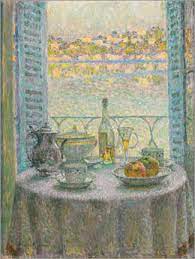
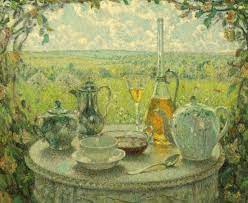
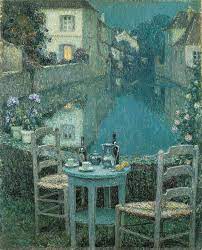








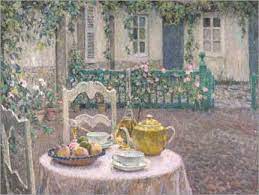
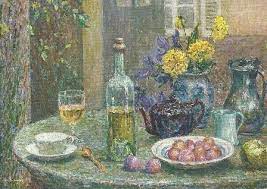






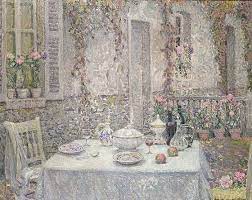





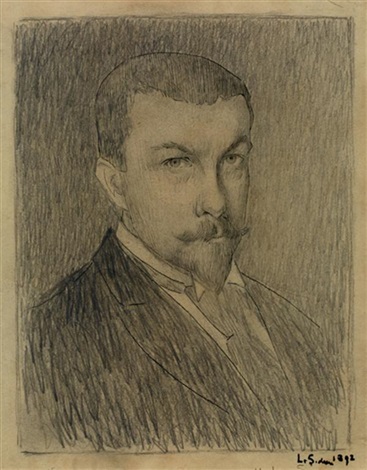

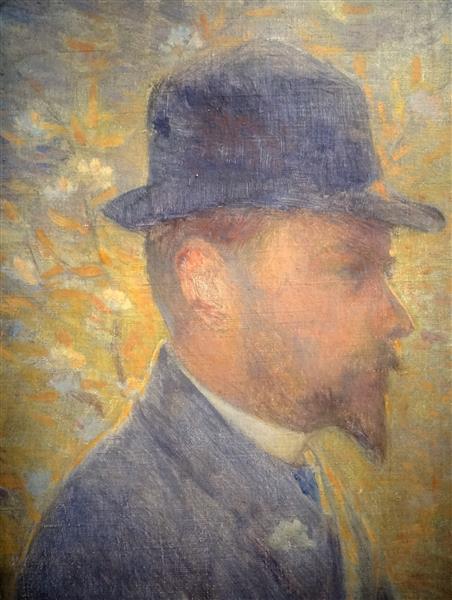



Comments